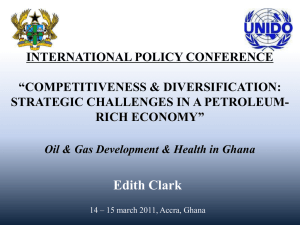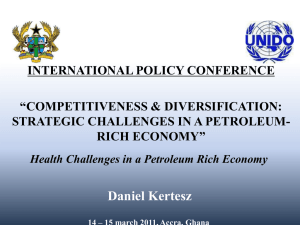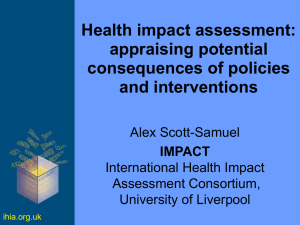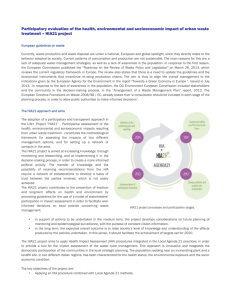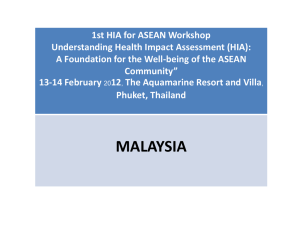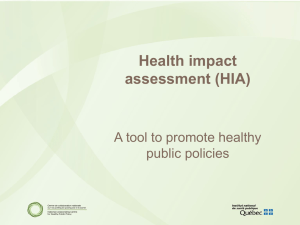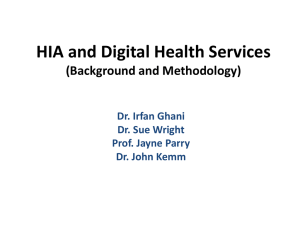Environmental health and chronic disease
advertisement
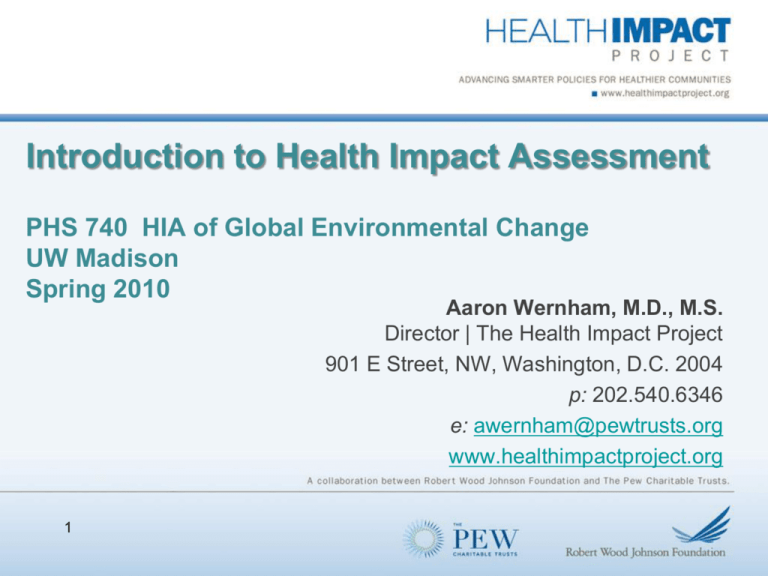
Introduction to Health Impact Assessment PHS 740 HIA of Global Environmental Change UW Madison Spring 2010 Aaron Wernham, M.D., M.S. Director | The Health Impact Project 901 E Street, NW, Washington, D.C. 2004 p: 202.540.6346 e: awernham@pewtrusts.org www.healthimpactproject.org 1 Public health • • • • • 10 % “health” care 30 % genetics 5 -25% “environmental factors” 15 % social circumstances 40 % “modifiable” behavior: • Diet, but… -food pricing, school nutrition programs, food deserts, advertising, etc… • Exercise … -mechanization, lack of walkable urban environments, danger, time constraints… Environmental health and chronic disease: an evolving relationship Environmental health -sanitation -pollution control -vector control Chronic disease HP/DP: focus on behavior modification: Diet & exercise guidelines, smoking cessation.. “Health in all policies” “Health and the built environment” Exercise: safe routes to school, access to parks, complete streets Diet: agricultural policy and food pricing, access to grocery stores 4 World Health Organization Ottawa Charter for Health Promotion Ottawa, 1986 The Prerequisites and prospects for health cannot be ensured by the health sector alone. More importantly, health promotion demands coordinated action by all concerned: by governments, by health and other social and economic sectors, by nongovernmental and voluntary organization, by local authorities, by industry, and by the media. Public Health: Where are we going? "(The) toxic combination of bad policies, economics, and politics is, in large measure, responsible for the fact that a majority of people in the world do not enjoy the good health that is biologically possible.” WHO Commission on Social Determinants of Health, 2009 Health in all policies.” APHA supports requiring all new federal policies and programs to take into consideration all Impacts, both positive and negative, on the public’s health. “Health is the responsibility of all sectors,” but… How No common language: do we put this into practice? transportation engineers don’t understand health data. public health professionals don’t understand the constraints and limitations of the planning process Few routine/formalized requirements No routine/formalized interaction between health and other sectors No funding for new public health activities “Going out on a limb:” Public health is science-driven, and policy and planning are governed by many other considerations: economics, politics, technology, deadines, etc … 7 Health Impact Assessment A combination of procedures, methods and tools that systematically judges the potential effects of a policy, programme or project on the health of a population and the distribution of those effects within the population. HIA identifies appropriate actions to manage those effects. (IAIA 2006, adapted from world health organization, 1999) A practical approach for collaborating with other sectors, translating public health research into predictions and reasonable recommendations that policy makers can use to ensure that new public decisions contribute to healthier communities. 8 The HIA Process 1. Screening –is HIA feasible and likely to add value? 2. Scoping – determine the important health effects, affected populations, available evidence, etc 3. Assessment – analyze baseline conditions and likely health effects 4. Recommendations, Implementation and Advocacy 5. Reporting – disseminate the report to the public, stakeholders, solicit input 6. Monitoring and Evaluation 9 Analytical Framework Proposed policy, project, program Determinants of health Health outcomes • Broad framework: considers multiple determinants and dimensions of health • Considers direct and indirect pathways • Qualitative and quantitative methods common • Focus: predicting outcomes, in order to manage effects • There may be conflicting influences on a health outcome: predicting the outcome may be less important than identifying the various influences on it, and managing them 10 Types of HIA Rapid Voluntary Retrospective Participatory Comprehensive Regulatory Prospective Procedural Initiated/conducted by: Community/ Industry Ad hoc 12 Agency Behind the standard definitions: what is it that really differentiates HIA? Is there anything besides the analysis and the report that defines the field? One possible answer: emphasis on engagement: brings public health professionals, community stakeholders, planners, developers, and decision-makers to the table, with a focus on practical, realistic solutions. 17 Public participation in HIA Not typically included in the basic definition of HIA, but it probably should be. Several variables: • Transparency: is the HIA public? • Public/stakeholder participation: does the HIA allow opportunities for key stakeholders to participate in the analysis? • Public input: does the HIA process afford the opportunity for the public to comment? • Accountability: how does the HIA respond to public comment? 17 Health Impact Assessment Current Applications: Canada and Australia: considerable work, both within EIA and for other policies and projects. EU: common use of HIA • broad applications in policy-making, land-use, etc • variety of governance structures U.S.: Roughly 60 HIAs to date: • Sporadic, often funded by foundations • Other than some EIA laws, no formal requirements 18 Health Impact Assessment International business is starting to use it. World Bank and IFC: part of evaluation standards for large development loans (IFC Guidance Note 4: http://www.ifc.org/ifcext/enviro.nsf/Content/GuidanceNotes) Equator Principles: ratified by the majority of large lending banks worldwide, the Equator Principles delineate ethical requirements for large development loans: they refer to IFC standards (http://www.equator-principles.com/principles.shtml ) 19 Completed HIAs in the United States 1999–2009 (N = 54) WA 4 MT 1 MN 5 OR 2 MI 1 MA 2 PA 1 OH 1 NJ 1 CO 2 CA 25 MD 1 GA 4 AK 3 FL 1 Courtesy A. Dannenberg, A. Wendel, CDC NCEH 20 HIA Compared to other analytic approaches • • • • Risk Assessment Environmental impact assessment Social impact assessment Evaluation 21 HIA Compared to other analytic approaches Evaluation “The systematic investigation of the merit, worth, or significance of an object:” • Can be retrospective or prospective • Asks “what happened, or what is happening,” not “what might happen?” • Generally focused on existing programs, policies, or projects (past or present events) Present Past Future Evaluation 23 Impact Assessment HIA Risk Assessment Focus of the Assessment Identify all of the pathways through which anticipated physical, social, and economic changes associated with a decision may affect health Calculate the risk associated with a specific exposure pathway Objective Identify all of the important links between an proposal and health, and manage the effects to benefit health Evaluate the risk of exposure to a certain potentially harmful substance or environmental factor. Methods -A mixture of quantitative and Generally quantitative qualitative/descriptive; modeling, based on a set of flexible, and dependant on baseline assumptions. the project being analyzed; -Participatory Conceptual Framework Broad/inclusive: social epidemiology, environmental justice Narrow, and often focused on specific dose-response information, toxicology. 24 HIA examples: San Francisco New housing development near congested roads • Decision: new zoning for a large housing development. --HIA done by SFDPH, in collaboration with Planning Dept • Example impact analysis and outcome: Impact: Air modeling showed air pollution “hot spots” closes to major roadway. Outcome: new buildings required to include particulate air filtration. 26 HIA examples: Humboldt County General Plan Alternative growth scenarios Three alternative growth scenarios: a. Focused infill: infill development – limited to current municipal boundary, locations where there is existing infrastructure b. Moderate growth: infill development, and limited expansion c. Expanded development: minimally restricted expansion outside current municipal border 26 Humboldt County General Plan HIA Examples of health determinants Alternative A Impact Alternative B Impact Alternative C Impact ST.4 Proportion of households with 1/4-mile access to local bus + ~ - ST.5 Proportion of average income spent on transportation expense + ~ - ST.6 Ratio of miles of bike lanes/pedestrian facilities to road miles + - - ST.7 Proportion of commute trips and trips to school made by walking or biking + ~ - Indicator 28 Description Humboldt County General Plan HIA Examples of health determinants Indicator 29 Description Alternative A Impact Alternative B Impact Alternative C Impact To be determined To be determined - ST.8 Number and rate of bicycle/pedestrian injury collisions ST.9 Proportion of population living on residential streets with <35 mph speed limits + ~ - ST.10 Percent of population who have access to pedestrian facilities + ~ - Oil leasing on Alaska’s North Slope 31 Nuiqsut, Alaska A small Inupiat community 7 miles from large oil development. Over 10 years, communities raised a wide range of health concerns as proposed development drew nearer to the community 32 Community health concerns “The benefits of oil development are clear -I don’t deny that for a moment. The negative impacts are more subtle. They’re also more widespread and more costly than most people realize. We know the human impacts of development are significant and longterm. So far, we’ve been left to deal with them on our own. They show up in our health statistics, alcohol treatment programs, emergency service needs, police responses – you name it." George Ahmaogak, Former Mayor of North Slope Borough Keynote Address, Alaska Forum on the Environment 2004. The First Federal HIA/EIS: Oil and gas leasing in the National Petroleum Reserve • Local government became a “cooperating agency” – a role defined by the National Environmental Policy Act through which local governments can formally participate in an EIS • The community health agency drafted an HIA through this role • The lead federal agency (BLM) incorporated the HIA into the EIS Result of the NPR-A HIA? Mitigation measures in the Northeast NPR-A EIS General Outcome: This was a very contentious leasing proposal. Community engagement via the cooperating agency relationship and HIA process resulted in: • Improved relationships between the community and the agency • A compromise leasing plan that was widely accepted on both sides 34 Result of the NPR-A HIA? Mitigation measures in the Northeast NPR-A EIS Health Concern Mitigation Measure Need to address health in planning future projects “Social ills”: alcohol, STIs, Air pollution BLM will consult with relevant health agencies in the development of future proposals in Northeast NPR-A Expand cultural orientation for workers Additional baseline, modeling, and monitoring above CAA requirements. Contamination of local Baseline levels and ongoing monitoring food sources 35 Other examples of HIA • Alaska: HIA of two large mines, done by two tribal health organizations and integrated into the EISs for those projects • Oregon: Upstream Public Health ( a non-profit group) health benefits of a range of strategies to reduce Vehicle Miles Travelled, for a new bill to reduce GHG emissions • California: an HIA of Humboldt County’s Growth Plan, commissioned by the County Health Department and supported by the Planning Department • Baltimore, MD: HIA by the Planning Department for a proposed new light rail project, the Baltimore Redline Visit www.healthimpactproject.org/hia or www.humanimpact.org for links The Health Impact Project CFP Examples of applications received to date 1.State Budget Process: Two applications to address state budget decisions, weigh the relative consequences of various likely budget cuts, safety net spending, etc 2.State Cap-and-Trade regulations: an HIA to inform the rulemaking process for California’s carbon cap and trade rule 3.Prison Reform: A university-based policy institute would address a state legislative package of 6 bills on prisoner reentry 4.Agriculture Policy: A non-profit would engage in a county agricultural plan that will shape the local economy, land use patterns, and diet. 5.State immigration legislation: a university would examine proposed state legislation to restrict access to public services 37 HIA Basics: Screening Dual challenges in screening: 1. How does a public health official identify the important legislative, administrative, regulatory, or private decisions that might benefit from HIA? 2. From the list of possible HIAs, choosing the projects most likely to add value. 38 HIA Basics: Screening 1. How does a public health official identify the important legislative, administrative, regulatory, or private decisions that might benefit from HIA? • Legislative tracking • Looking at federal and state EIAs • Collaboration with planning dept, education dept: set up routine meetings, working groups -- build a culture of collaboration 39 HIA Basics: Screening 2. From the list of possible HIAs, choosing the projects most likely to add value. • Are there likely health effects? • Is health already being considered? HIA may add the most value to decisions where health is not the focus. • Does the public have health concerns? • Is the HIA likely to be successful? • Are there legal or regulatory levers that would allow implementation of health recommendations. • Do you have the resources to do the HIA? 40 HIA Basics: Scoping 1. What aspects of the proposed project, policy, or program might affect health? 2. What are the potential health effects? 3. Who will be affected? • Geographic boundaries • Demographics • Vulnerable populations 4. Who are the stakeholders? 5. What are the data sources? Data gaps? 6. Public comments: what are the public’s concerns? 41 Scoping: Determining important health pathways • Logic Frameworks • Scoping tables 43 Logic Frameworks Policy/ Project Education: safety training Engineering: improve pedestrian facilities, traffic calming Enforcement: increase police presence, crossing guards Dedicated resources: walking school busses Proximal/Intermediate Impacts Health Outcomes walkability safety Motor vehicle use Injury Air and noise pollution Asthma Obesity Physical activity 44 EXAMPLE: using a table for systematic scoping Air Quality Injury Infectious Disease Chronic Illness Hazardous Mat. Exp. Psychosocial 45 Water Quality Subsistence Economy Demographics Big Picture: Cap & Trade HIA Components Revenue CA Cap & Trade # of Allowances & Allocation Strategy Buy/Sell Allowances Carbon Price Covered entity Buy/Sell Offsets On-site Reductions Potential Health Impacts1 Alternatives 1Potential 46 health impacts can be positive, negative or neutral Assessment: Basic steps 1. Describe the baseline health status, and factors that influence health. 2. Analyze the impacts 49 Indicators for HIA analysis In order to describe the baseline, you need to select appropriate indicators. A good indicator should: • • • • Measure something likely to be affected by the proposed action Measure something important to health Occur frequently enough that you can reliably measure changes. The information should be available, or readily obtained within the resources available for the HIA! 50 www.thehdmt.org 52 Assessment step 2: Analyze the impacts Impact assessment in HIA can be: • Quantitative – modeling, risk assessment • Qualitative or descriptive: - Nature of impacts - Direction of impacts - Literature review Severity Beneficial Mild problem supporting the analysis - Expert opinion Probability Unlikely/ 53 / Frequency rare Uncertain Likely/ common Moderate problem Severe/lifethreatening Assessment: what is the goal? A case example Basic concern: oil and gas development could displace caribou, and have a significant adverse impact on food security. Pathway analysis (based on available studies of similar projects): • Seismic exploration and pipelines can push caribou farther from communities and potentially reduce harvest • Revenue from oil and gas to local Alaska Native corporations has actually increased harvest by facilitating purchase of better hunting equipment, fuel, etc. Take home point? While it is going to be very hard to accurately predict the impact on food security, identifying the conflicting pathways allows management to improve health outcomes. 54 Assessment Step 2: Analyze the Impacts Prominent public concerns Prevalent Health Problems and Health Disparities Environmental Consequences in other areas (air quality, economy, etc) Public Health Consequences 55 Public Health Data (literature review) and expert opinion Assessment Your data are incomplete, your predictions are uncertain… What to do?? … Adaptive Management 56 HIA Recommendations What are you hoping to accomplish? • Stop a proposed project? • Promote legislation? • Maximize benefits and minimize harms associated with alternatives under consideration? • Establish a strong platform for good management ? 57 Recommendations, implementation, and advocacy: A few key points 1. A clear plan of how you will promote implementation of the recommendations is essential 2. The line between scientific neutrality and advocacy is challenging! 3. HIA recommendations are most effective when they account for the “real time” political, regulatory, economic, and technological context . 4. The strategy varies based on who is doing the HIA: - Health agency doing HIA at the request of another agency - EJ group advocating for or against a proposal - University center trying to provide unbiased information - Agency leading a formal process such as EIA 58 Reporting Key Issues • Transparency: is the report public? • Response to public input: - Will there be opportunity for the public to comment on a draft? - How will comments be responded to? • Dissemination: - How to ensure stakeholders are aware of it and can view the HIA? - Accessibility: is there a non-technical summary? What about the languages of stakeholders? Monitoring and Evaluation A few key points 1. Unfortunately, it’s often not done! 2. Huge opportunity for public health: in some cases, it may be possible to build monitoring for health indicators into a project or policy implementation plan – a largely unexplored opportunity to fund public health surveillance efforts. 3. If possible, each recommendation should include monitoring parameters 4. What are you evaluating? • The impact/outcomes of the HIA • The impact/outcomes of the decision addressed by the HIA 60 HIA Evaluation A few key points 1. Start by asking, “What were we hoping to achieve?” • Improvements in health outcomes? • Improvements in health determinants? • Influencing the design of a project or the implementation of a new policy or regulation? • Increasing awareness of/dialogue about public health in nonhealth sectors? 61 Was the HIA was “successful”? Health issues adequately acknowledged? Decisions modified due to HIA? YES YES Direct effectiveness: Changes made because of HIA NO Opportunistic Wismar M, et al. Effectiveness of HIA. WHO, 2007 effectiveness: Health-promoting choice made anyway NO General effectiveness: HIA acknowledged but changes not made; health awareness raised No effectiveness: HIA ignored 62 HIA: the stages from the standpoint of effective cross-sectoral engagement HIA Stage Eg. of cross-sectoral strategy Screening Early discussion of HIA, HIA training for all stakeholders Scoping What are policymaker’s constraints, concerns, practical limitations? Assessment What information do other sectors bring? AQ? Traffic models? Do they understand our data? Reporting Peer review by other stakeholders, policymaker: honest efforts to address all concerns Recommendations What can policymaker do, practically? Why are some options more or less viable Monitoring and Evaluation Can policy maker require monitoring? Are there funding streams from outside public health? The Health Impact Project: A collaboration of the Robert Wood Johnson Foundation and The Pew Charitable Trusts www.healthimpactproject.org Overall Objective: To promote and support the use of HIA as a tool to ensure that decisions in nonhealth sectors, whether at the local, state, tribal, or federal level, are made with health in mind. Geography AK WA WI WY AR AZ VA TN TX OR PA CA OH CO CT NM NY NH NJ DC NE FL NC MT MA MS We have reviewed GA MO ME LA IL HI LOIs from 35 states! MN KY MD 65 Subject AreaHousing Policy, 2% Education, 3% Natural Resources and Energy, 6% Air Quality/ Contaminant Cleanup, 6% Agriculture, 6% Topic of HIA Climate Change, 2% Health Promotion, 2% Labor/ Employment Policy, 2% Land Use/ Development/ Transportation/ Urban Planning 28% Other, 6% Economic Policy, 6% Maternal/Child Health, 8% Healthcare, 12% Obesity Prevention/Fitnes s/ Nutrition, 13% Discussion? 67

